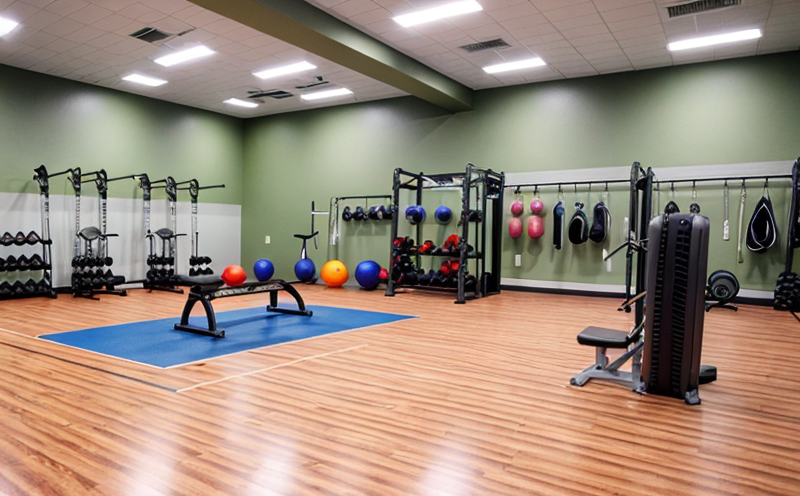Spring Resistance Testing in Trampolines
In the realm of consumer products and product safety testing, particularly within the category of sporting goods and fitness equipment, spring resistance testing is a critical procedure. This service involves assessing the resilience and structural integrity of trampoline springs to ensure they meet stringent safety standards and perform optimally under expected loads.
Trampolines are not only a source of entertainment but also essential recreational equipment that can pose significant risks if not designed, manufactured, or tested properly. The springs in a trampoline are the primary load-bearing components, responsible for absorbing impact forces during use. Ensuring these springs meet specific resistance criteria is paramount to prevent accidents and guarantee user safety.
The testing process typically involves subjecting individual springs to a series of standardized loading cycles until failure or the specified limit cycle count is reached. This procedure simulates real-world conditions, including the weight and frequency of typical users. The goal is to determine how well each spring can resist deformation under these forces without compromising structural integrity.
Standard testing methods for trampoline springs often follow international guidelines such as ISO 12549-3:2016 (Sports equipment—Trampolines and similar apparatus—Part 3: Safety requirements) and ASTM F973-18, which provide detailed protocols on specimen preparation, instrumentation selection, loading procedures, and acceptance criteria. Compliance with these standards ensures that manufacturers meet both national and international safety regulations.
During testing, it is crucial to prepare the springs by cleaning them thoroughly to remove any dirt or debris that could interfere with accurate measurement. The springs are then mounted onto a suitable testing apparatus designed specifically for this purpose. Once installed, they undergo cyclic loading until either a predetermined number of cycles have been completed or the spring fails under load.
The results from these tests provide valuable insights into the durability and performance characteristics of each trampoline spring. Engineers can use this data to refine designs, improve materials selection, and enhance overall product quality. Additionally, compliance with regulatory requirements demonstrates commitment to safety standards, fostering trust among consumers and enhancing brand reputation.
By conducting comprehensive spring resistance testing, manufacturers not only safeguard users but also contribute positively to public health by reducing the likelihood of accidents associated with poorly designed or manufactured trampolines. This service plays a vital role in maintaining high-quality standards across the sporting goods industry, ensuring that every product meets rigorous safety benchmarks.
Benefits
Conducting spring resistance testing offers numerous advantages for manufacturers and retailers alike. Firstly, it enhances user safety by identifying weak points in trampoline springs early in the production process. This proactive approach helps prevent potential accidents that could result from compromised structural integrity.
Secondly, compliance with international standards like ISO 12549-3:2016 and ASTM F973-18 ensures adherence to regulatory requirements, thereby mitigating legal risks associated with non-compliance. This can save companies significant costs in terms of fines or recalls.
Thirdly, reliable testing data enables manufacturers to optimize spring design and material selection, leading to improved product performance and longevity. Consumers appreciate products that offer consistent quality and reliability, which translates into higher customer satisfaction rates.
Moreover, participating in rigorous testing protocols positions brands favorably within competitive markets by demonstrating a commitment to excellence and safety. This reputation can drive increased sales and market share growth.
In summary, spring resistance testing is an indispensable service for ensuring the quality and safety of trampolines. It provides tangible benefits across multiple dimensions, including enhanced user safety, reduced legal risks, optimized product performance, and improved brand positioning.
Quality and Reliability Assurance
Quality assurance in the context of trampoline spring resistance testing involves several key aspects that ensure consistent and reliable results. The first step is meticulous specimen preparation, which includes cleaning springs thoroughly to remove any dirt or debris. This ensures accurate measurements during loading cycles.
The choice of instrumentation is equally critical; high-precision load cells capable of measuring incremental forces are essential for capturing detailed data points throughout the testing process. Calibrating these instruments regularly guarantees their accuracy and reliability.
Proper loading techniques play a vital role in obtaining representative results. Cyclic loading should follow prescribed protocols outlined in relevant standards such as ISO 12549-3:2016 or ASTM F973-18 to simulate realistic user conditions accurately. Monitoring loads and displacements continuously allows for real-time adjustments if necessary.
Finally, robust data analysis ensures that all collected information is interpreted correctly. Statistical methods help identify trends within datasets, allowing engineers to make informed decisions regarding design improvements or material changes based on empirical evidence rather than assumptions.
By adhering strictly to these quality assurance practices, laboratories can deliver consistent and reliable test results, building trust with clients who rely on accurate data for decision-making purposes. Consistency in testing procedures also facilitates easier comparability between different batches of products or across various models within a product line.
Use Cases and Application Examples
The application of spring resistance testing extends beyond just trampolines; it applies to many other types of sporting goods where resilience against impact forces is crucial. For instance, in the case of bicycles, forks need similar robustness tests to ensure they can handle various terrains without failing.
In football helmets, the ability to absorb impacts safely during collisions is paramount. Testing these helmets through standardized resistance protocols helps manufacturers identify potential weaknesses early on, ensuring enhanced protection for athletes.
Similarly, in cricket bats, impact resistance testing ensures they can withstand powerful hits without breaking or compromising performance characteristics such as balance and swing weight.
For skateboards, wheels require rigorous testing to guarantee durability under repeated use. This includes assessing their ability to maintain shape and roll smoothly even after extensive wear and tear.
In summary, spring resistance testing is not limited to trampolines but has broad applications across various sporting goods categories where resilience against impact forces is essential for maintaining safety standards while delivering optimal performance.





